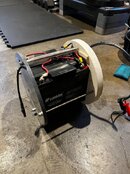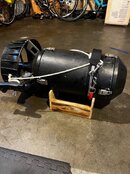I had planned on waiting until after I finish Tech 1 to start looking at DPVs, but a friend just gave me his old Gavin DPV when he was cleaning out his garage. It has newer SLA batteries and the original brushed motor and everything appears to work. I took it down to the ship canal today to test buoyancy and trim and, in fresh water, it took 5 lbs of lead to get it to be just barely positive (which I understand is the goal at the surface since the body o-rings will compress slightly at depth.) I figure I'll use it until I figure out what I really need in a DPV -- heck, it was free anyway.
My question now is how to do the rigging for the tow cord and the tow leash (for stowing it during the dive or if it breaks down.) I want to have the tow cord length be adjustable when I am starting out so I can find the right length. I'm comfortable tying a taught-line hitch to make the length adjustable, but I'm not sure where on the Gavin to attach the tow cord. There are cutouts in the struts that I could loop the tow cord through and route them around the outside of the shroud. Or I can loop it around the handles with the fixed side on the trigger side and the adjustable loop on the non-trigger (left) side, but in that case the large, adjustable loop could come off the handle.
For the tow leash, I've seen it recommend to attach it under the hose clamp used to attach the front handle, but I am concerned with the PVC body that having a line under the hose clamp will cause the PVC to distort when it is tightened down which might cause the nose o-ring to not seal. Am I being overly paranoid?
Thanks for any help or photos of how you've got your vintage DPVs rigged.
My question now is how to do the rigging for the tow cord and the tow leash (for stowing it during the dive or if it breaks down.) I want to have the tow cord length be adjustable when I am starting out so I can find the right length. I'm comfortable tying a taught-line hitch to make the length adjustable, but I'm not sure where on the Gavin to attach the tow cord. There are cutouts in the struts that I could loop the tow cord through and route them around the outside of the shroud. Or I can loop it around the handles with the fixed side on the trigger side and the adjustable loop on the non-trigger (left) side, but in that case the large, adjustable loop could come off the handle.
For the tow leash, I've seen it recommend to attach it under the hose clamp used to attach the front handle, but I am concerned with the PVC body that having a line under the hose clamp will cause the PVC to distort when it is tightened down which might cause the nose o-ring to not seal. Am I being overly paranoid?
Thanks for any help or photos of how you've got your vintage DPVs rigged.






